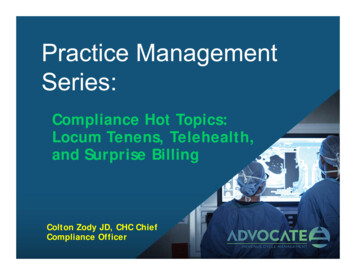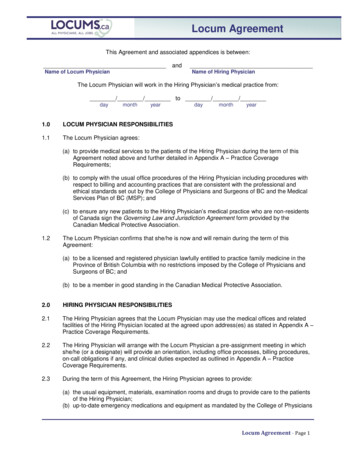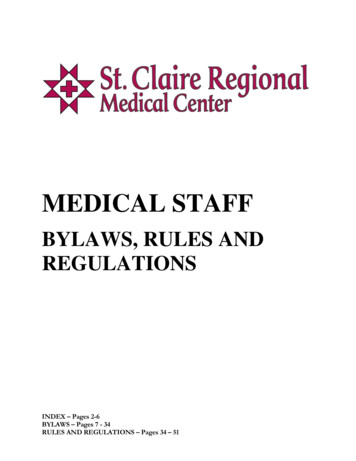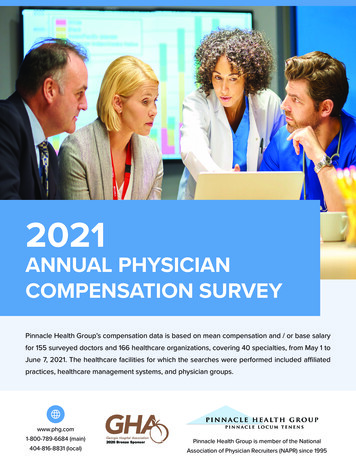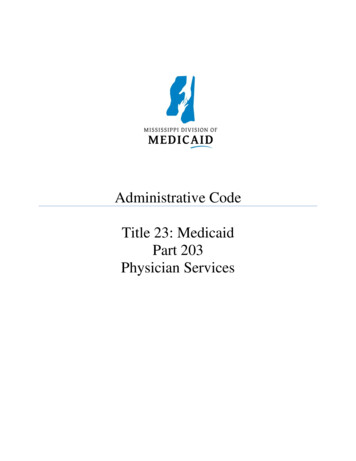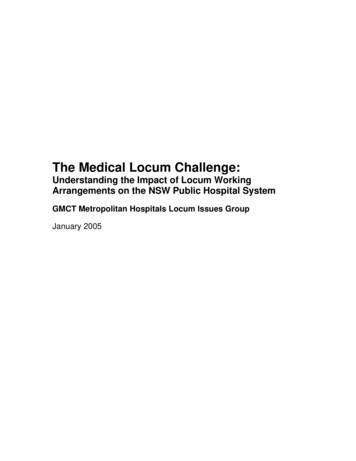
Transcription
The Medical Locum Challenge:Understanding the Impact of Locum WorkingArrangements on the NSW Public Hospital SystemGMCT Metropolitan Hospitals Locum Issues GroupJanuary 2005
ContentsPageExecutive Summary3Part 1:An Issues Paper61. Definitions2. How Widespread are Locum Arrangements?3. Why Have Locum Arrangements Grown?4. What Has Been the Impact of the Emergenceof Locum Arrangements?5. How Does the Experience of NSW Health Comparewith Other Sectors?6. Future DirectionsPart 2:Experiences of Locum Work:Interviews with Recent Medical Graduates21Part 3:Locum Arrangements at a NSW MetropolitanHospital: An Illustrative Case Study25References30Glossary32Appendix 1: Membership of GMCT Metropolitan HospitalsLocum Issues Group33Appendix 2: Hospital Vacancies from Med Survey 200434The Medical Locum Challenge2
The Medical Locum Challenge:Understanding the Impact of Locum Working Arrangements onthe NSW Public Hospital SystemGMCT Metropolitan Hospitals Locum Issues GroupExecutive SummaryThe use of locum medical officers to fill junior and middle level shifts in the NSWpublic hospital system has increased alarmingly in recent years. Doctorsproviding these services include recent medical graduates and specialist traineeswho have interrupted their training, and experienced clinicians who have workedpreviously in the hospital system as Career Medical Officers. Temporary doctorsare used to provide cover for permanent staff on leave, but are also increasinglyused to manage chronic vacancies, with appointments ranging from days toyears.The use of doctors without postgraduate vocational training as a temporaryhospital workforce poses significant challenges to the NSW public health system,including cost, quality and safety of clinical care, legal and administrative issues,and sustainability of the trained medical workforce.CostLocum doctors are not employed under a public hospital medical officer awardand can expect to earn up to three times the award rate. Most locums areemployed through a locum agency, and the agency will usually charge thehospital a commission of 10-15% per shift filled. Agencies provide little morethan introductions and price negotiations. They do not take responsibility forensuring that the doctor is adequately skilled for the position or for training locummedical officers.NSW Health conducted a survey of the hospital workforce in February 2004which indicates that there are over 900 junior and middle level vacancies in NSWgreater metropolitan hospitals, most notably in emergency medicine. Thesevacancies are largely filled by overseas-trained doctors and locums.Aconservative estimate is that over one year employment of locums to fill thesepositions costs NSW Health 30 million dollars more than the cost that would beincurred by employing permanent staff, with an additional 5.2 million dollars perannum going to locum agencies.Quality and SafetyThere is enormous variability in the skills of medical practitioners working aslocums in the hospital system. Doctors can undertake locum work as early aspostgraduate year 2 (PGY2). There are no systems for ensuring that locumshave necessary clinical skills for positions that they fill. No system is in place forThe Medical Locum Challenge3
ongoing training or performance review of doctors working in locum positions.Locums work across a number of health facilities and their working hours are notmonitored to protect personal and patient safety.Further safety issues surrounding employment of locum medical staff includelack of continuity of care, lack of familiarity with the employment setting includinglocal hospital process and protocols, lack of adequate supervision and clinicalsupport if required, and the possibility of impaired relationships with local staffdue to resentment of the pay differential.Legal and Administrative IssuesEmployment arrangements for locum doctors in the public hospital system havesignificant legal and administrative implications which are generally poorlyunderstood by hospital administrators and locums themselves. Doctors may beengaged as a temporary hospital employee or as a private contractor. A locumengaged as an employee is provided with superannuation, workers’compensation insurance and medical indemnity by the employing public hospital.A locum engaged as a contractor is responsible for their own indemnity. Locumsinsured as a ‘recent graduate’ (PGY1-5) by an indemnity provider are unlikely tobe insured for work with public patients in the public hospital system whileworking as a private contractor. Locums insured as ‘senior medical officers’(PGY5 ) are more likely to have adequate cover.Locum doctors are not employed pursuant to a hospital medical officer award.The industrial and legal implications of this arrangement are not clear. Liabilityfor decisions made by doctors working in the public hospital system outside theaward structure is untested in NSW to date.Locum doctors generally do not participate in hospital or college-based trainingprograms and are therefore unlikely to satisfy Continuing Medical Education(CME) requirements for registration with the NSW Medical Board.Sustainability of the Medical WorkforceThe increasing trend for doctors to undertake locum work poses a threat to thesustainability of the hospital medical workforce in NSW. Increasing demand forhospital services, changes to provider number legislation and General Practicetraining, changing demographics of the medical workforce, reduction of workinghours and shifts in societal attitudes favouring lifestyle over career haveeffectively reduced the number of doctors available for salaried hospitalpositions. In a time of workforce shortage, locum work, which offers betterremuneration and flexibility than permanent hospital employment, appeals to anincreasingly large number of junior doctors, diverting them away from vocationaltraining programs and reducing the number of trained specialists available to theNSW hospital system in the future.The Medical Locum Challenge4
Future DirectionsThere is currently insufficient information about the hospital medical workforce inNSW to accurately predict the impact of increasing reliance on locum medicalofficers on cost, quality of patient care and sustainability of the hospital medicalworkforce in NSW.There is an urgent need to clarify legal and industrial implications of employmentof locum medical officers outside relevant industrial awards, including provisionof medical indemnity insurance, liability for decisions made by locum doctors,potentially restrictive trade practices of locum agencies, occupational health andsafety of locum doctors including safe working hours, and responsibility forensuring quality of locum medical officers including credentialing, performancereview and continuing medical education. Relevant industrial awards should bereviewed to explore the relationship between industrial conditions and hospitalworkforce trends.The GMCT Metropolitan Hospitals Locum Issues Group is currently examiningpotential options for short and medium term solutions to address the issuesraised in this paper. Comments and suggestions should be provided to:Clare SkinnerProject Manager – Locum Issues02 8877 5112caskinne@doh.health.nsw.gov.auThe Medical Locum Challenge5
The Medical Locum Challenge:Understanding the Impact of Locum Working Arrangements onthe NSW Public Hospital SystemPart 1: An Issues PaperClare Skinner, John Buchanan, Kerry Goulstonfor the GMCT Metropolitan Hospitals Locum Issues Group (see Appendix 1)Purpose: To clarify the key issues surrounding the emergence of locumemployment arrangements in NSW public hospitals.1. Definitions1.1 What is a Locum?The term ‘locum’, from the Latin locum tenens (to take the place of) is used todescribe a variety of employment arrangements within the medical profession.Traditionally, a ‘locum’ was a medical practitioner engaged to act as a substitutewhile the regular medical practitioner was absent. Substitute doctors were fullyqualified, independent medical practitioners employed to replace a specialist orGP for a finite period, usually in a private practice setting.In recent years, ‘locums’ have been increasingly used to fill junior and middlelevel shifts in the hospital system. Temporary doctors are used to provide coverfor permanent staff on leave, but are also increasingly used to fill longer-term jobvacancies in the capacity of an Intern, RMO, Registrar or CMO. The majority ofdoctors who provide this service are themselves recent graduates or specialisttrainees who have chosen to interrupt their training. They often requiresupervision to provide safe and effective clinical care. Many of these doctors donot have relevant postgraduate vocational qualifications and are not participatingin a relevant college training program. The locum workforce also includes apopulation of doctors with many years of clinical experience but no vocationalspecialist qualification who have chosen locum work as a long-term careeroption. These doctors have usually worked in the public hospital system asCMOs and possess necessary clinical skills to work unsupervised.The use of doctors without vocational specialist training as a temporary medicalworkforce poses significant challenges to the NSW public hospital system. Forthe purposes of this paper a ‘locum’ will be defined as a doctor who:- does not have postgraduate vocational specialist qualifications- does not work under a public hospital medical officer award- is employed on a temporary basis (usually under 3 months but mayextend to years).The Medical Locum Challenge6
The definition includes those doctors who are employed full time in the hospitalsystem and take on extra shifts (‘moonlighting’) and those doctors, for whomlocum work is the primary source of clinical employment, including overseastrained doctors (OTDs). Issues raised by temporary employment of medicalpractitioners with specialist qualifications will not be addressed in this paper.1.2 How do Locum Arrangements Work?In most cases, doctors and hospitals interact via a locum agency. Doctorsinterested in doing temporary shifts register with an agency, providing theircurriculum vitae, names of referees and copies of relevant documentation (egprimary medical degree, medical registration, evidence of citizenship, medicalindemnity). The doctor may also be asked to complete a checklist of clinicalskills and experience, although relevant certification is not usually sought orchecked. Hospital administrators contact the agency and advise available shiftsand the agency finds a suitable doctor, either through telephone contact, theinternet or SMS. Price negotiations are undertaken by the locum agency. Thedoctor can expect to receive up to 3 to 4 times the award rate for a locum shift(see Table 1). In addition, the agency receives a 10-15% commission from thehospital for each shift filled. Shifts to be filled at short notice are deemed ‘crisisshifts’ and rates increase accordingly. Should a locum be asked to join thepermanent staff of an employing hospital, most agencies demand a ‘finder’s fee’(up to 20 000) and ongoing commission for the first six months. The majority oflocums do not sign a contract with the agency and may be unaware of thiscondition which potentially restricts their future employment opportunities ashospitals will choose to employ an applicant who is not attached to an agency toreduce costs.Table 1: Comparison of Award and Locum Rates (per hour)ShiftAward Rate (1)Junior – DayJunior – NightJunior – HolidaySenior – DaySenior – NightSenior - Holiday 24.04 – 26.44 27.04 – 29.74 42.06 – 46.27 29.94 – 42.21 33.68 – 47.49 52.39 – 73.87Locum Rate‘Crisis’ Rate(Estimates from locum doctors andhospital administrators) 70 – 80 90 – 120 80 – 90 100 – 130 90 – 120 130 – 150 80 – 100 110 – 130 90 – 100 120 – 150 120 – 130 150 – 160Note – Junior: RMO1 (PGY2) - RMO2 (PGY3), Senior: Registrar 1 (PGY3 ) - Senior Registrar(PGY5 )Alternatively, a hospital may engage the services of a temporary doctor directly.In this case, the factor that differentiates a locum from a casual employee ispayment of above-award ‘locum rates’. Award classifications and rates of pay forhospital medical officers are strictly enforced by NSW Health (2). Hospitals inareas of workforce shortage may opt to provide financial incentives not availableThe Medical Locum Challenge7
under the award system by paying so-called ‘locum rates’ in order to attractmedical staff.A locum may be employed to fill either regular or ad hoc shifts. A locum may beengaged as a hospital employee, in which case they sign an employmentcontract and are taxed through the PAYE (Pay As You Earn) system, or theymay be engaged as a private contractor and be paid through an ABN (AustralianBusiness Number). The employment status of the locum has significant financialand legal implications. A locum engaged as a temporary public hospitalemployee is provided with superannuation, workers’ compensation insurance,and medical indemnity by the employing hospital. When a locum is engaged asa private contractor, the employing hospital has no responsibility for provision ofsuperannuation, worker’s compensation insurance or medical indemnity. Legalliability for decisions made by locums employed by public hospitals outside ahospital medical officer award appears not to have been tested in NSW to date.Three major medical insurance organisations were contacted to clarify indemnityarrangements for locum medical practitioners. A locum indemnified as a ‘recentgraduate’ (PGY 1 – 5) is covered for limited work with private patients only, as itis assumed that their public practice will be indemnified by the employing publichospital. Without arranging additional cover, a locum registered with their insureras a ‘recent graduate’ has no indemnity to cover work with public patients whenemployed as a private contractor by a public hospital. It is unlikely that mostjunior locums are aware of these limitations and have arranged appropriate coverfor their locum practice. Indemnity for senior medical practitioners (PGY 5 andabove) includes cover for work performed in a locum capacity.To obtain medical registration in NSW, doctors are required to demonstrate thatthey are participating in Continuing Medical Education (CME). CME of locummedical practitioners is contentious. The NSW Medical Board was contacted toclarify requirements. Most recent medical graduates and specialist traineessatisfy CME requirements through participation in a hospital or college-deliveredtraining program. It is unlikely that most doctors covering junior and middle levelhospital shifts in a locum capacity meet these conditions, although somehospitals do encourage locum staff to participate in hospital teaching sessions.The NSW Medical Board has limited power to enforce CME participation andcurrently it is only after three years of not providing evidence of CME that anindividual practitioner will be asked to justify ongoing registration to the MedicalBoard.Access to provider numbers, which enable patients to claim rebates for medicalservices through the Medicare system, is also problematic for locum doctors.Provider numbers are linked to discrete practice settings, thus are difficult toobtain for doctors working temporarily in a number of health facilities. The HealthInsurance Commission (HIC) was contacted to clarify arrangements. The patientof a doctor working without a valid provider number in a public hospital isThe Medical Locum Challenge8
potentially unable to claim rebates for specialist referrals, outpatient diagnosticservices and assistance provided during surgery as a private patient. The HICperforms regular audit of doctors’ provider numbers but acknowledges that thereis little disincentive for an individual doctor to work without a valid setting-specificprovider number. Prescriber numbers, which allow patients to access discountedmedications through the Pharmaceutical Benefits Scheme, are allocated todoctors on completion of the intern year and are not facility-specific.Whether a locum is engaged as an employee or a private contractor, it is unlikelythat either the hospital or the agency is taking responsibility for their occupationalhealth and safety, including appropriate vaccinations, blood borne virus status,tuberculosis monitoring and safe working hours. Hours worked by doctors who‘moonlight’ are especially difficult to monitor. Salaried doctors are required toobtain permission from hospital administration for work conducted outside theirprimary employing hospital, although few doctors do this in practice.It is unlikely that the majority of locum medical officers are fully aware of thepotential legal and financial implications of their employment arrangements.Locum agencies in NSW do not take responsibility for these matters on behalf ofthe locum doctor or employing hospital.2. How Widespread are Locum Arrangements?2.1 StatisticsStatistical data regarding use of locum medical practitioners to fill junior andmiddle level vacancies in the NSW hospital system are sparse. Most hospitalworkforce surveys either exclude locums or define medical practitionersaccording to the position they fill, thus do not clearly differentiate locums fromregular employees. The NSW Medical Board collects information about theemployment arrangements of medical practitioners as part of annual registrationdocumentation but does not specifically ask about locum work undertaken bysalaried hospital doctors.Limited information about use of locum doctors can be found in Med Survey2004, a survey conducted by NSW Health in February 2004 using hospitalpayroll records (3). Med Survey 2004 attempts to quantify medical practitionersaccording to hospital, specialty and employment status. The survey alsoquantifies hospital vacancies and how they were managed, providing informationabout current shortages of junior and middle level hospital medical officers byarea and specialty, and information about employment of locums and overseastrained doctors (OTD) to address these vacancies. Preliminary results from MedSurvey 2004 are presented in Appendix 2. Survey results indicate that vacanciesare present throughout the hospital system with the greatest shortfalls occurringon the urban fringe. The specialties most affected include Emergency Medicineand Adult Medicine, and to a lesser extent, Anaesthesia, Psychiatry, andThe Medical Locum Challenge9
Obstetrics and Gynaecology (O&G). Survey results do not allow identification ofthe specialty in which a locum or OTD was employed. It should be noted thatinformation is not available for all hospitals in the greater metropolitan area,including some known anecdotally to use locums. It is difficult to estimate thetrue extent of the doctor shortage as there are no guidelines for medical staffingof public hospitals outside emergency departments, and accurate data about thetotal number of doctors employed in the NSW public hospital system and numberof doctors in vocational training positions were not available. The need toprovide maximal staffing 24 hours per day to meet episodic patient demand inthe emergency setting means that vacancies in Emergency Medicine are likely tobe over-represented compared to vacancies in specialties which providelongitudinal care and therefore have less requirement for out-of-hours staff cover.In February 2004, there were a total of 906 vacancies in NSW greatermetropolitan hospitals, including 243 vacancies at Intern (PGY1) and RMO(PGY2) level, and 663 vacancies at Registrar (PGY3 ), CMO (PGY4 ) andOther levels (not defined but assumed PGY3 ). There were 348 vacancies inEmergency Medicine. These hospital vacancies were filled by 640 OTDs and179 locums, leaving 87 vacancies to be covered by regular staff. Assuming tenhour shifts and minimum locum rates from Table 1, these locum doctors costNSW Health at least 142 500 per day. In addition, assuming 10% commission,locum agencies earn at least 14 250 per day, bringing the total daily cost oflocum doctors to at least 156 750. In contrast, assuming maximum rates of payunder the award, permanent employees would cost only 74 452 per day. Aconservative estimate is that, over one year, employment of locum doctors costsNSW Health at least 30 million dollars above the costs that would be incurred byemploying permanent staff, with an additional 5.2 million dollars per annum goingto locum agencies.Several hospitals report no use of locums in Med Survey 2004, includingCanterbury Hospital, Concord Hospital, and Royal Prince Alfred Hospital inCentral Sydney, John Hunter Hospital and the Mater in Newcastle, Prince ofWales Hospital and St George Hospital in South Eastern Sydney, BankstownHospital in South Western Sydney, and Westmead Hospital in Western Sydney.Many of these hospitals are tertiary referral centres and may find it easier toattract and retain both local and overseas staff due to size, clinical and academicreputation, and specialist patient throughput, all of which contribute to the abilityof a hospital to provide teaching, supervision and a collegiate atmosphere. Itshould also be noted that Med Survey 2004 was conducted in February, a timewhen hospitals are likely to have maximal staffing levels. In July and August,many UK and Australian doctors resign from NSW hospitals in order to seek UKhospital positions on commencement of the new UK academic year. Followingthe hospital medical officer recruitment period in August to September each year,a number of Australian doctors leave the system. It is therefore likely thatvacancy rates described in Med Survey 2004 are more optimistic than would bethe case if hospitals were surveyed later in the year.The Medical Locum Challenge10
2.2 Previous ReportsNo existing reports fully describe use of locums in the NSW hospital system.Several related reports refer to growing reliance on temporary workforce at juniorand middle level. A considerable body of research has reviewed use of specialistand GP locums, particularly in the rural setting, but the issues described do nottranslate to the employment of medical practitioners without postgraduatevocational qualifications as locums in the hospital system.The Audit Office of NSW conducted a review of delivery of services to patients inNSW public hospital emergency departments in 2000 (4). The review found thatstaffing levels in emergency departments significantly affected waiting times andcritical incidents in the emergency setting. The mix of staff varied considerablyacross the site hospitals reviewed, with only one hospital adhering to theAustralian College of Emergency Medicine (ACEM) staffing guidelines. Thereport directly refers to the practice of employing doctors from locum agencies tofill vacant shifts:‘Most hospitals employ doctors from locum agencies to fill casual vacancies onthe roster (although the principal referral hospitals were keen to avoid having todo this). Hospitals indicated that where they had trouble rostering doctors to fillunpopular shifts in the emergency department (such as nights and weekends),locum doctors were employed. For example one site employed locum doctorsfrom Friday to Sunday to cover the weekend and night shifts.Those hospitals employing locum doctors did not report any concerns regardingthe quality of treatment. However, additional costs are incurred and possiblerisks to patient care may need to be better managed.Although senior medical staff reviewed the resumes of locum doctors before theycommenced duty, mechanisms for reviewing the performance of these doctorswere weak or non-existent. Also, for locum doctors working in unfamiliarsurroundings there was often insufficient induction and little, or no, supervisionavailable.’ (4)The Audit Office of NSW review of public hospital emergency departmentsrecommends that locum staff be replaced with full-time staff where possible andthat minimum skill requirements for locums be introduced along with appropriateperformance review procedures (4).The Australian Medical Workforce Advisory Committee (AMWAC) MedicalCareers Survey 2002 provides information about the employment status ofvocational trainees (5). AMWAC conducted a postal survey of all doctors invocational training in Australia (including general practice) in September 2002 toexplore the determinants of choice of medical discipline, satisfaction with careerdecisions, working conditions and short and long term career plans. Of 7899doctors eligible for participation, 54% provided completed surveys. Of these4259 doctors, 89.4% were practising in a vocational training program, 4.4% (187)were on leave and intending to return to training, and seven had decided to leavemedicine as a career. Of the doctors who indicated that they were on leave,69.4% were female and 28.7% were training in general practice. 28.8% ofThe Medical Locum Challenge11
female doctors and 10.3% of male doctors indicated that they intended to taketime out in the next three years and 1.4% of doctors intended to leave medicinealtogether. Reasons for taking time out included:‘A 3-6 month break to travel, to gain balance in my life, to prevent or to cope withburn-out, to recharge my batteries, to spend quality time with my family, to allowmy partner to pursue his or her career, or to have a baby.’ (5)An additional 12.8% of doctors in training planned to undertake a higher degree.It is likely that vocational trainees either taking a break or undertaking higherstudy will contribute to the locum workforce.Hawthorne and Birrell reviewed the impact of doctor shortages on the quality ofmedical care in Australia in 2002 (6). Their report describes an under-supply ofdoctors resulting from deliberate policies to curb growth of the medical workforceduring the 1990s and increasing reliance on overseas-trained doctors (OTDs),often on temporary visas, to fill critical vacancies in the hospital system. Whilelocums are not directly mentioned, use of OTDs involves similar problems suchas lack of accreditation of clinical skills and familiarity with individual hospitalsettings. The areas in which OTDs are mainly used include Emergency Medicineand Psychiatry; areas which also had large numbers of vacancies in preliminaryresults from Med Survey 2004 (see Appendix 2). Hawthorne and Birrell state:‘In our view the current shortage of doctors will not be resolved by increasingdoctor remuneration. These shortages are chronic and are inherent within thestructure of the medical workforce. More doctors are needed.’ (6)Shortages of junior doctors and non-specialist hospital medical officers,inadequate numbers of GPs, and insufficient medical graduates to fill places inpublic sector specialist programs (especially those which are least attractive) arelisted as evidence of a doctor shortage in Australia (6). The PostgraduateMedical Council of NSW (PMC), which allocates local medical graduates toIntern and RMO positions according to a needs-based quota system, currentlylists 19 vacancies for local graduate RMOs on their web-site (7). It is moredifficult to quantify vacancies in specialist training programs, as detailedinformation is not available from the colleges however preliminary results fromMed Survey 2004 indicate widespread vacancies at Registrar level particularly inEmergency Medicine (see Appendix 2).A recent Medical Training and Education Council (MTEC) review of postgraduatemedical training in NSW (8) acknowledges the contribution of unstreamedtrainees (PGY 3 and above), CMOs and locums to the hospital workforce and thelack of appropriate training systems for these doctors, stating that:‘Significant service gaps across the NSW health system are filled with locumstaff, no system exists to identify or meet the training needs of this group.’ (8)Among the recommendations of the MTEC review is a request for more accurateworkforce data to allow better prediction of both supply and demand anddevelopment of appropriate training systems.The Medical Locum Challenge12
Concerns about increasing use of locum medical officers were raised by DrElizabeth Swinburn, then Director of the Emergency Department at Mona ValeHospital in a letter to the Medical Journal of Australia in August 2002 (9). Shewrites:‘There are significant disadvantages for the locum doctor (eg lack of ongoingeducation from patient follow-up, feedback about mistakes, mentor and peersupport; inadequate supervision of “safe working hours”) and for the healthcaresystem (eg lack of continuity of care; locums’ unfamiliarity with the hospital andits procedures; variable skill levels of locums; resentment by regular staff of payrate discrepancies; cost). While there is no doubt a role for locum doctors withinthe healthcare system, there is no overall control of the situation.’ (9)She raises concern that neither hospitals nor locum agencies take responsibilityfor training locum staff. It should be noted that concerns about rising numbers oflocums and rostering pressure placed on permanent staff when doctors in PGY 2drop out of the mainstream workforce to do locum work were also raised byInterns and RMOs at the PMC Junior Medical Officer Forum in September 2003(10).It is difficult to identify all locum agencies in Australia. A search of the AustralianBusiness Register and the Australian Securities and Investments Commission(ASIC) Company Register was conducted, but business entities do not have todeclare their primary activity on either register. An internet search revealedseveral agencies advertising junior and middle level shifts in NSW hospitalsincluding agencies based interstate, in the United Kingdom, the United States ofAmerica and New Zealand.3. Why Have Locum Arrangements Grown?The most superficial explanation for the emergence and growth of locumarrangements is medical workforce shortage. As described by Hawthorne andBirrell, there are not enough local medical graduates to fill junior hospi
vacancies are largely filled by overseas-trained doctors and locums. A conservative estimate is that over one year employment of locums to fill these positions costs NSW Health 30 million dollars more than the cost that would be incurred by employing permanent staff, with an additional 5.2 million dollars per annum going to locum agencies.


